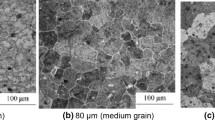Abstract
The analysis of lateral extrusion process was carried out. A three dimensional FE model was developed to analyze the effects of some important geometrical parameters such as initial billet dimensions, gap height and frictional condition on the required forging load, the material flow pattern and effective plastic strain distribution. The FE code of DEFORM-3D was employed. A series of experimental tests on commercial lead billets were carried out to verify the FE results. The simulation work has been performed by the rigid-plastic FE method. The results obtained using the numerical solutions have been compared with the experimental data for each case study in terms of required forming load and material flow pattern in different regions. Comparison between FE and experiment results showed good agreement. Both the simulation and experimental results highlight the major role of above mentioned parameters on the required forming load and material flow pattern. The results showed that the gap height has the greatest effect on the forming load and material flow. The results presented in this paper could be used as basic data in the design of the lateral extrusion process.
Similar content being viewed by others

References
M. Plancak, A. Brameley and F. Osman, Non-conventional cold extrusion, J Mater Process Technol 34 (1992) 465–72.
H. Y. Cho, G. S. Min, C. Y. Jo and M. H. Kim, Process design of the cold forging of a billet by forward and backward extrusion, J Mater Process Technol 81 (2003) 135–375.
D. Y. Yang and K. J. Kim, Design of processes and products through simulation of three-dimensional extrusion, J Mater Process Technol 191 (2007) 2–6.
B. D. Ko, D. Kim, S. Hyung and B. B. Hwang, The influence of die geometry on the radial extrusion processes, J. Mater. Process 113 (2001) 109–114.
A. Buschhausen, K. Weinmann, Y. J. Lee and T. Altan, Evaluating of lubrication and friction in cold forging using a double backward extrusion process, J Mater Process Technol 33 (1992) 95–108.
H. -J. Choi and Hwachoi, The forming characteristics of radial-backward extrusion, J. Mater. Process, 113 (2001) 141–147.
R. Ebrahimi, M. Reihanian and M. M. Moshksar, An analytical approach for raial-forward extrusion process, Matre Des 29 (2008) 1694–700.
A. Farhoumand and R. Ebrahimi, Analysis of forwardbackward-radial extrusion process, Matre Des 30 (2009) 2152–2157.
Y. S. Lee, S. K Hwang, Y. S. Chang and B. B. Hwang, The forming characteristics of radial-forward extrusion, J Mater Process Technol, 113 (2001) 136–140.
Y. Can, M. T. Altinbalik and H. E. Akata, A study of lateral extrusion of gear like elements and splines, J Mater Process Technol 166 (2005) 128–134.
Y. Can and C. Misirli, Analysis of spur gear forms with tapered tooth profile, Mater Des 29 (2007) 829–838.
S. K. Hwang, D. H. Jang, B. D. Ko and B. B. Hwang, The forming characteristics of simultaneous radial-forward extrusion processes, Mater Sci Forum 4 (2005) 475–479:4171.
R. Balendra, Yi. Qin and R. Balendra, Computer-aided design of Nett-forming by injection forging of engineering components, J. Mater. Process. (76) (1998) 62–68.
R. Balendra and Y. Qin, Identification and classification of flow-dependent defects in the injection forging of solid billets, J. Mater. Process. 106 (2000) 199–203.
R. Balendra and Y. Qin, Injection forging: engineering and research, J. Mater. Process. 145 (2004) 189–206.
T. Mizuno and K. Kitamura, An experiment on injection upsetting, J. Mater. Process. 96 (1999) 234–9.
M. Zadshakoyan and H. Jafarzadeh, Numerical study of the die geometry and friction effect on the forming load and material flow in injection forging process, Journal of Applied Sciences, 9 (2009) 2174–2179.
DEFORM-3D software user Manual, Scientific Forming technologies Corporation, V5.0, Scientific Forming Technologies Corporation, Columbus, OH. 2005.
T. Altinbalik and Y. Can, An experimental study of lateral extrusion of splines, J. Mat. Des. 27 (2006) 727–734.
R. Ebrahimi and A. Najafizadeh, A new method for evaluation of friction in bulk metal forming, J. Mater. proc. Technol. 152 (2004) 136–143.
Author information
Authors and Affiliations
Corresponding author
Additional information
Recommended by Associate Editor Youngseog Lee
Hossein Jafarzadeh is a Ph.D student at Tehran University in manufacturing engineering. He got his M.Sc in metal forming field at Tabriz University in 2009. He has many research papers in precision metal forming processes. He has worked as a researcher in the Engineering Research Center from 2007. His current research interests are in severe plastic deformation methods, crystal plasticity finite element methods and net shape precision metal forming methods.
Rights and permissions
About this article
Cite this article
Jafarzadeh, H., Faraji, G. & Dizaji, A.F. Analysis of lateral extrusion of gear-like form parts. J Mech Sci Technol 26, 3243–3252 (2012). https://doi.org/10.1007/s12206-012-0830-8
Received:
Revised:
Accepted:
Published:
Issue Date:
DOI: https://doi.org/10.1007/s12206-012-0830-8



